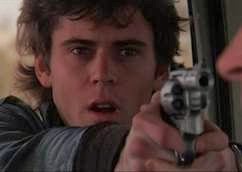FATHER'S DAY (2011) (NR) Dirs. Adam Brooks, Jeremy Gillespie, Matthew Kennedy, Steven Kostanski, and Conor Sweeney
aka THE FATHER'S DAY MASSACRE99 mins.
Like House of the Devil and Hobo with a Shotgun before it, Father's Day is recorded with the aesthetic of a late 70's or early 80's grindhouse flick. Specifically, it 's made to look like it was taped off the TV with a VHS, channel bumpers and all. There is even a fake trailer halfway through the film, a la the movie Grindhouse. Everything looks authentic; the film's frames are scratched and linty, the colors are saturated to a ridiculous degree, there are jittery splices in the footage, and the score is pure Moogy deliciousness.
The story revolves around the legend of the Fuchman. Chris Fuchman to be precise, an obese necrophile who likes to kidnap fathers, rape and kill them. When Fuchman kills a priest and kidnaps stripper Chelsea from the club she works at, it's up to three intrepid heroes, film noir reject and Chelsea's brother Ahab, male hooker Twink, and Father John, to rescue her and stop the Fuchman.
They follow in hot pursuit of Fuchman and Chelsea following the abduction, chasing Fuchman's truck, but ultimately lose him and fail to rescue Ahab's sister. The day is fading, so they pitch camp until morning. During the night, Twink and Father John eat hallucinogens and fuck.
The next day, they follow Fuchman's trail to a waterslide park, where they discover a corpse and a terribly wounded Chelsea. Ahab engages a fleeing Fuchman, unleashing a flurry of handgun rounds and shotgun shells into his body. After Fuchman falls, Ahab stomps in his skull and hurls the body off the side of a ledge.
The trio's victory is short-lived, although, as it is discovered that the Fuchman is actually a demon of sorts, a spirit that is reborn each generation. He has Chelsea's soul and is using her as his vessel. Yet Fuchman is in Hell. So Hell ahoy! Ahab and the boys load up a pistol and prepare to kill the Fuchman, on his home turf, and end his reincarnations.
Father's Day is vile, disgusting and hilarious. It revels in breaking taboos and making the audience uncomfortable. Male on male rape, Catholic homosexuality, abortion, genital mutilation, and incest, all make their appearances. The gore is both cartoonish and gruesome. The whole movie is brilliantly shot and edited, and the comedy mostly hits its mark. The acting is hammily self-aware and the many homages and parodies (i.e. Escape From New York, Twin Peaks, Phantasm) are clever and respectful.
Easily recommendable to gorehounds, Troma fiends, and fans of black humor. It's a goldmine, but as with most of Troma's fare, it's definitely not for the squeamish. 7/10

.png)
.jpg)


.png)

.png)
.png)
.png)
.png)

.jpg)

.png)


.png)

.jpg)
.png)

.jpg)

.jpg)
.jpg)
.png)
.jpg)
.jpg)
.png)
.jpg)
.jpg)
.png)

.png)

.png)



.jpg)
.jpg)
.jpg)
.png)


.jpg)
.png)
.png)
.jpg)
.jpg)